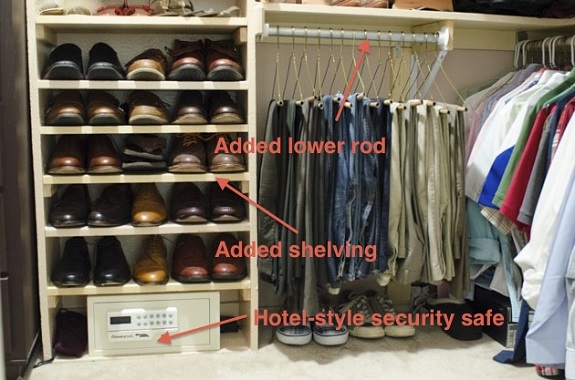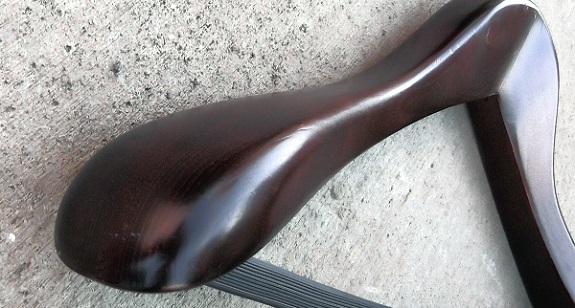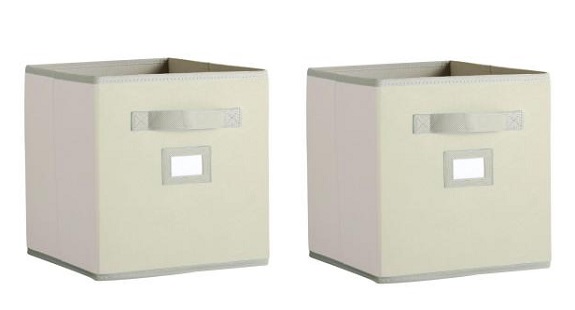The Dappered philosophy is all about looking good without costing an arm and a leg. While that usually means finding great pieces and even better prices, this series is about how to store what you’ve already got. We’re going to look at how to clear the clutter, how to outfit a closet, and how to use that closet to its full potential.
If you’re following along, you’re well on your way to clearing the clutter. You won’t be fully de-cluttered if you’re using the “reverse hanger technique” (step 3 here), but you should still be off to a pretty good start.
Now, we’ve got to customize your closet to meet your needs. Just as an organized workspace can help you be more productive, an organized closet can help make you better-dressed. There are a few extra steps that can help you take your closet to the next level, and most of them are pretty cheap.
11 TIPS FOR OUTFITTING YOUR CLOSET
1. No blank walls
You’ll want to maximize your space BEFORE you start filing it up. That means you need to create as much useful space as possible with what you have, and blank walls are not useful space. If it’s your own closet, build out more shelves or rod space (whichever you find yourself needing more of). If it’s an apartment, throw a chest of drawers against that wall. You can’t ever have too much useful space, but you can easily have too little. So again, do this first, even if you don’t think you’ll need it. Trust me, Sooner or later, you’ll need it.
 #2, #8, and #10 in action in the wild.
#2, #8, and #10 in action in the wild.
2. Double rods
If you don’t have to share your closet with a woman, you don’t need full-height rods. Instead, add a second rod underneath to double your rod space. If you have a 3/4 length rod, you may want to consider keeping it if you have longer jackets, unfolded hanging pants, or any coats for which you can’t find another home. If you have to share a closet with a woman, well, You’re not really sharing. It’s her closet. You’re just squatting.
3. White doesn’t lie
When light bounces off of a colored surface, it reflects a “cast” that changes the color of the light. This will screw up the color of anything else that the light shines on. So in order to get the most color accuracy out of your wardrobe as possible, you’ll want to introduce as much white as you can. Having white walls is a no-brainer, but also consider painting you cabinetry white. This will help your clothes to be more true-to-color when they’re hanging on the rods. Since white surfaces reflect full-spectrum light, it’ll also be brighter. And as we’ll discuss in rule #5, we’ll need all the light we can get.
4. Use full-spectrum or “daylight” fluorescent bulbs
Traditional incandescent bulbs typically have a red or orange hue to them. Switching to fluorescent bulbs can fix the situation, but make sure you’re getting full-spectrum or “daylight” bulbs. Full-spectrum bulbs are preferable since they provide pure white light, but daylight bulbs are the next best thing. They have a very slight blueish tint that mimics standing underneath a blue sky on a bright day. Since the light is more accurate, you’ll be able to see what your clothes REALLY look like. If you have a reach-in closet or wardrobe, just replace the lights in your bedroom.
5. Make it as bright as possible
It’s common knowledge that as light gets dimmer, your vision starts to break down. However, what many people don’t realize is that your ability to see color is the first thing to go. This can be avoided by providing as much light in your closet as possible. This is easy to do with the fluorescent bulbs mentioned above. Since they run at lower wattages than incandescents, you can get brighter bulbs than you could normally use. Most closets have only one or two bulbs so make them work for you. And since fluorescent bulbs take a minute or two to really warm up, turn on the light a few minutes BEFORE you go browsing.
6. Hang a full-length mirror on the door
Even if you have no room to hang a mirror out in the open, you can always hang one inside the closet door. The benefit of a full-length mirror is obvious for seeing your whole ensemble at once. Ever have trouble deciding which shoes to wear? Ever have trouble deciding if the pants are working with that jacket? Problem solved.
7. Use proper hangers for suits/jackets/pants/etc
This may be obvious, but it’s so important that it’s still worth mentioning. Suits and sport coats have structured shoulders that can be damaged over time if left on skinny hangers. These pieces will often be sold on a hanger which you can continue to use. Otherwise, you should go out and get some. Pants on a thin wire hanger will leave a crease. At the very least, they need a wider bar. In truth, those basic cardboard pant hangers from the dry cleaner work just fine if you’re on a budget. But if you’ve got the funds, dedicated pant hangers are going to be better.
 Now that my friends… is a hanger. Wide shoulders to support blazers, sportcoats, etc.
Now that my friends… is a hanger. Wide shoulders to support blazers, sportcoats, etc.
8. Use a hotel-style safe for valuables
Whether it’s a $1000 watch or just a $5 tie clip your grandpa gave you, some things cannot afford to be stolen. There are tons of safes on the market, but if you’re not concerned about fire damage, a simple security safe will work just fine (and save you a few bucks in the process). Plus fire safes can be difficult to secure to a floor or shelf whereas security safes are specifically made for that purpose. SentrySafe makes a a Card Access Security Safe in creme that fits easily on an existing shelf and blends well into its surroundings. It’s just large enough to hold the things that matter without taking up too much space for everything else. Is it the Vault at the Bellagio? No, but if you secure it with the included bolt down kit, it should provide enough resistance against a smash and grab job.
9. Use cubicle drawers for clean storage
Closets often come with shelves when what you really want is more drawers. These cubicle drawers have a handle on the front and a label to let you know what’s inside. They’re designed to fit into cubby holes, but they also fit conveniently well onto closet shelves and for overhead storage. Any time you’re tempted to stack something, think about using a cubicle drawer. They really help cut down the clutter.
 Can’t stop it? Contain it. With these.
Can’t stop it? Contain it. With these.
10. Double your shelf space
Most closet shelves are spaced 12″ apart. If you like to store your shoes on shelves, that can leave a lot of wasted space. You should leave one of two shelves alone for boots, but you can pack more shoes into the rest by adding additional shelves between the existing shelves. If you have a modular closet, it’s as easy as adding pegs and dropping in more pre-fabricated shelf pieces. Otherwise, you’ll have to do it the old fashioned way. Pine 1″x12″ boards from your local lumber yard or Home Depot can be cut into sections (usually 2 feet) and attached using 1″x2″ cleats. Since most built-in closet shelving is 12″ deep (unless you have higher-end 16″ closet shelves), a 1″x12″ is going to be VERY close to the correct size. It may not be very pretty, but damn it’s easy.
11. Accessorize and customize
At this point, you have a closet that will work for 90% of the people out there. However, everyone is different. Most guys will want a belt rack, but even a hook or a long nail will work. If you have a lot of ties, a tie rack will be in order. As for me? I’ve got my eye on a wall-mounted shoe shine butler. It’s your closet so make it yours. Customize how you see fit. But remember, it’s a place to effectively store your clothes. So if Xzibit shows up to Pimp your Closet, that’s probably going overboard.
Coming up Wednesday, Part III: Building a System for moving forward. When not de-creasing shoes or keeping his closet in good shape, you’ll find Roving Style Contributor Alan S. participating as an active member on Threads.
